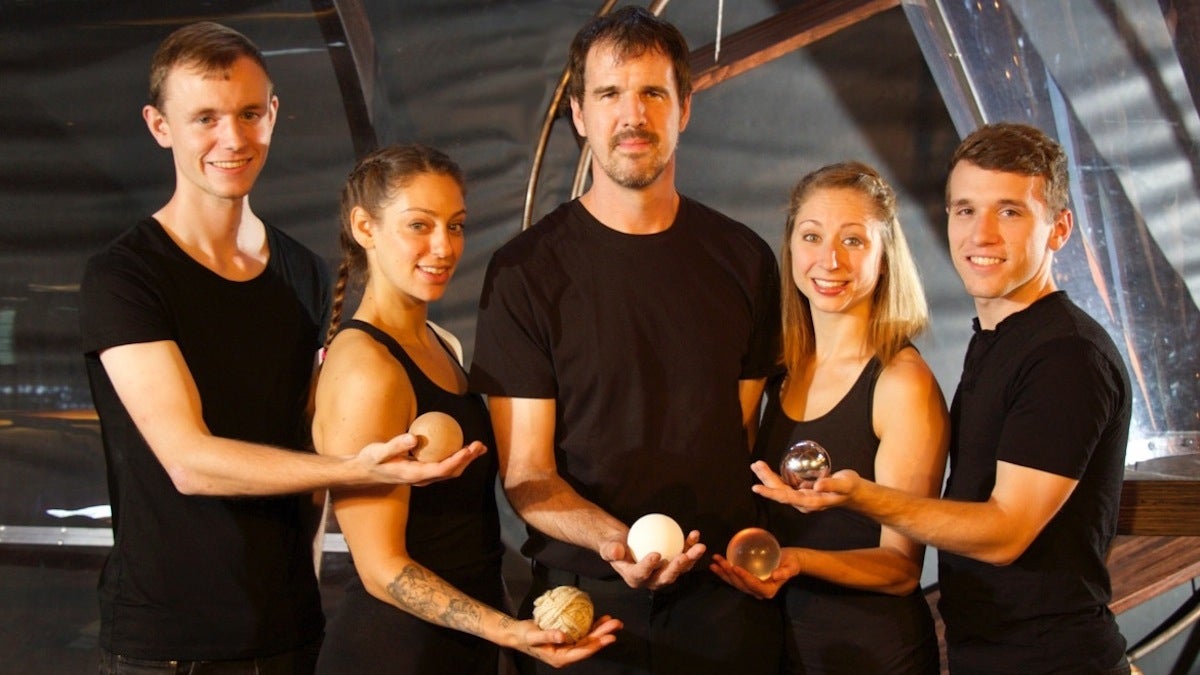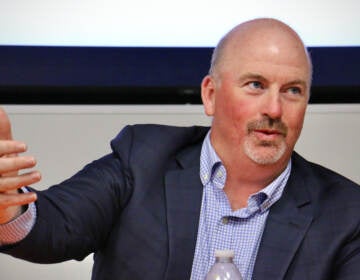Philly Fringe brings Cirque du Soleil juggler back to Germantown

The cast of 'Theorem.' Greg Kennedy is in the center. (Courtesy of FringeArts)
It’s amazing enough to watch someone with the focus and dexterity to turn a handful of objects into a circling toss-and-catch waterfall, but with a performer like Germantown’s Greg Kennedy, it’s not juggling so much as conjuring a small, whirling galaxy with his bare hands.
At this year’s Fringe Festival, the “Innovative Juggler” brings his skills home for “Theorem,” running at Germantown’s Funicular Station through the festival’s Sept. 21 finish.
“For the last five years, I’ve been on tour with a much larger production,” Kennedy told Friday’s full house inside the small, recently-rehabbed, barn-like performance space between SEPTA’s Queen Lane and Chelten Avenue stations.
That larger production happens to be Cirque du Soleil, where Kennedy had a role in the show “Totem.” He also helped to develop the production’s routines, which Kennedy says Cirque continues to use.
Kennedy has returned home to Northwest Philadelphia with his wife, aerialist Shana Kennedy, founder of the Philadelphia School of Circus Arts, and their kids.
A longing for something smaller
In his introduction to the crowd at the opening of his new show, the engineer-turned-juggler says his latest piece, performed with the help of a single musician and four other circus artists (two men and two women), was the result of a “longing” to work on something intimate and personal.
When Kennedy begins to juggle, it’s impossible for the layman to fathom how he does it, let alone count how many balls he actually has in the air.
“Theorem” includes a variety of acts, including a breathtaking corde lisse duo and a perfectly boggling set of wooden boxes that hurl apart, fit together, balance in a perfect zigzag tower, and then collapse down into one another at just the right touch. There’s also a whirling metal machine that’s one part see-saw, one part trapeze, and one part human Ferris wheel.
After dusk falls through the skylights of the slanting wood ceilings, the strings of white circus lights go dark for a hypnotic dance routine of glowing white globes, and it’s hard to say whether the performers are extensions of the objects they use, or the other way around.
That’s part of Kennedy’s unique genius.
From juggling to engineering and back
He got his undergrad degree in engineering from Drexel University, Kennedy told NewsWorks after the show, but he’s loved juggling ever since he was a kid. After finishing his degree, he worked as an engineer in New York for a few years, but never lost his childhood passion.
“I found that I spent all my free time juggling,” he said. In the 1990s, he began to combine his engineering expertise with juggling arts in completely new ways, designing and building objects that expanded his repertoire far beyond the human hands.
These include a special device that looks like a clear plastic bowl, its mouth a few feet wide, sitting on legs like a cauldron. Kennedy and his cast juggle a cluster of white balls while hurling them in and out of the plastic bowls, where the balls fly and return like tiny daredevil skateboarders on the perfect ramp.
Kennedy said the bowl device had its world premiere in 1996, when he won the gold medal at the International Jugglers’ Association Championships. The next year, he quit his engineering job to explore juggling full time, which led to his stint with Cirque du Soleil, as well as TV appearances including a spot on Jay Leno’s Tonight Show.
Juggling machines
“Theorem,” which is billed as “a playful look at the process of invention, as told through juggling and circus arts,” boasts its own world-premiere contraption: a clear plastic tube large enough for the cast to stand inside (or dash through), with the juggling balls whirling around them in perfect orbit.
Another machine, which looks like a giant wooden square set inside a metal circle on wheels, allows Kennedy to juggle while bouncing the balls off the insides of the square, producing a visual spectacle as well as a catchy rhythm, until the square begins to rotate and the balls hurtle into a gallop under Kennedy’s flawless control.
Leaving Cirque for the Philly Fringe
After the show, Kennedy spoke more about what could lure an artist of international renown away from a gig like Cirque du Soleil and back to Germantown.
The juggler emphasized that he loved his years on the road, where his family joined him, but that something else always tugged at him.
“With Cirque, it’s just so big that everything moves so slowly,” he explains of how the sheer scale of the production could prove frustrating for an artist bubbling with fresh concepts.
“My sketchbooks grew and grew and grew and grew, but I never had a reason to finish anything,” he said. “As an artist, I was ready to move on.”
And that led to the premiere of “Theorem,” bringing Fringe-goers from across the city to Germantown, where Kennedy reanimates the smaller-scale (but no less fantastic) feats that drew him to juggling in the first place. The artist, who still has new acts in the works, hopes to expand and continue the show beyond this year’s Fringe.
“Theorem” is running as part of the Philadelphia Fringe Festival at the Funicular Station, 416 W. Coulter St., through Sept. 21. For tickets and more information, visit the show’s website or call FringeArts at (215) 413-1318.
WHYY is your source for fact-based, in-depth journalism and information. As a nonprofit organization, we rely on financial support from readers like you. Please give today.




